It’s odd that the sportiest car in its class has less engine than the others in its class. The car is the Mazda6 – and it comes only with a four.
Meanwhile, you can get a V6 in rivals like the Toyota Camry, Honda Accord and Nissan Altima.
But don’t blame Mazda for this. 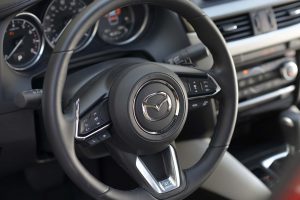
The reason the 6 no longer offers a six has to do with the difficulty of meeting Corporate Average Fuel Economy mandatory MPG minimums – 35.5 MPG at the moment; if your fleet averages less, you get hit with “gas guzzler” taxes, which are tacked on to the price of the car, making it less competitive in the market.
CAFE fatwas are particularly hard on companies like Mazda, which sell fewer cars than the volume sellers like Toyota, Honda and Nissan.
They can afford to offer sixes in their sedans because they build (and sell) so many four cylinder-powered versions. The relatively small number of thirstier sixes they sell get lost in the wash.
To give you some idea: Toyota sells around 35,000 Camry sedans each month. Honda is slightly second. It sells about 30,000 Accords per month.
Guess how many Mazda6 sedans are sold each month?
About 3,500.
Toyota and Honda sell more cars in about five weeks than Mazda sells in a year. And that’s what lets them “get away” with – to use the perverse language of our time – offering V6s in their sedans – while Mazda no longer can.
But, it’s not all dreary news.
You can still get a manual transmission in the Mazda6 while the Camry and Altima are automatic-only, regardless of the engine you pick – and the 2017 Accord’s optional V6 only comes with an automatic transmission.
The Mazda’s also got lines.
If there’s a better-looking car in this class, I must’ve missed it.
A Miata with four doors and trunk space.
Well, almost.
In terms of driving verve, it’s close.
Unlike most of the others in this class – which is the mid-sized sedan class, priced in the low $20s to start – the Mazda6 is a car made for people who need a practical family car but still enjoy driving. As opposed to sitting behind the wheel.
If you understand the distinction, you will appreciate the car.
Base price is $21,945 for the Sport trim with a six-speed manual transmission; if you prefer to go with the optional six-speed automatic, the price rises to $22,995.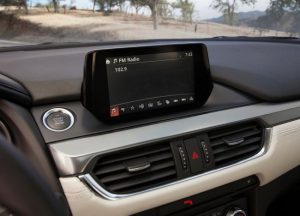
A top-of-the-line Grand Touring with the automatic stickers for $30,695.
Other cars in this class/price range include the Toyota Camry (base price $23,070) which is more focused on being a quiet family car. And the Honda Accord (base price $22,355) which is focused more on being a tech car.
The closest shave for the 6 is probably the Nissan Altima ($22,900 to start) which is also sportier-than-most and is available with a powerful V6. However, the Altima’s only transmission – whether you stick with the standard four cylinder or buy the optional V6 – is a continuously variable (CVT) automatic. You can’t get a manual.
Which takes away points from the Fun-to-Drive factor.
In addition to standard Torque Vectoring Control – a system that automatically adjusts power delivery to the front wheels in relation to steering angle – you can now get heated rear seats.
Grand Touring trims come standard with Lane Keep Assist and you can also order a Traffic Sign Recognition system with the Grand Touring trim.
WHAT’S GOOD
The car for the person who wants a Miata – but needs the extra seats.
Standard manual transmission.
No turbo, CVT or ten speed automatic.
Lower starting price than others in this class.
As enjoyable to look at it as it is to drive it.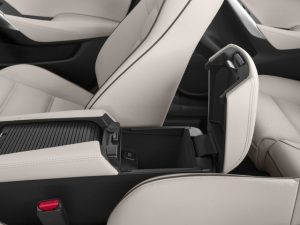
WHAT’S NOT SO GOOD
No six for this 6.
No turbo for the four.
No wagon version of the 6 for us (they sell one in Europe and Japan).
Great-looking LCD touchscreen; not-so-easy-to-use knob input.
Tiny center console storage cubby.
Most of the cars in this class have a standard and optional engine; the 6 comes standard with – and only offers – one engine. It’s a 2.5 liter four that makes 184 hp and 185 ft.-lbs. of torque. No turbo, but very high compression (13.0:1) which is great for power (and efficiency) but usually requires the use of high octane premium fuel to avoid engine knock.
But that’s not the case here.
Mazda’s “SkyActiv” design allows high-compression without high-octane, which is important for more than just power because it’s a significant money-saver since high-octane premium gas generally costs 20-30 cents or more per gallon than regular unleaded. You save about $3 per tank filling up the 6’s 16.4 gallon tank with regular vs. premium. If you fill up five times a month, that works out to about $15 per month, about $200 per year. If you own the car eight years, you’ll save $1,600 or so at current prices.
The 6’s four also saves you money the straightforward way – by burning less of it. EPA rates the manual-equipped 6 at 24 city, 34 highway; 26 city and 35 highway with the optional six-speed automatic.
This beats the four cylinder/automatic-only Camry (24 city, 33 highway) as well as the four cylinder Accord with manual transmission (23 city, 32 highway). If you order the Accord with the optional continuously variable (CVT) automatic transmission, the mileage upticks to 27 city, 36 highway – slightly better than the 6 automatic-equipped 6. But the price you pay for that slight MPG advantage is the disadvantage of the CVT’s shrieky operating characteristics vs. a conventional automatic, as in the Mazda.
Same Catch 22 with the Nissan Altima – which only comes with a CVT whether you stick with the standard 2.5 liter four or buy the optional 3.5 liter V6.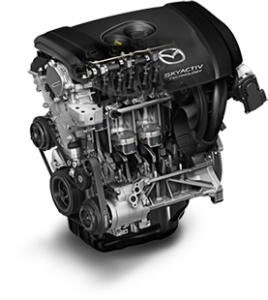
The 6’s standard engine stacks up well vs. the standard engines you’ll find in other sedans in this class; it’s more powerful (Camry’s standard 2.5 liter four makes 179 hp; the Accord’s standard 2.4 liter four makes 185 hp; the Altima’s standard 2.5 four makes 179 hp) uses less gas and gives you better acceleration – zero to 60 in about 7.5 seconds.
The others – with their standard fours – need about eight seconds to make the same run.
But, the others offer an upgrade. Camry, Accord and Altima all can be ordered with larger – and much stronger – V6 engines: 3.5 liters, 270 hp in the Camry; 3.5 liters, 278 hp in the Accord and 3.5 liters, 270 hp in the Altima.
Equipped with these engines, the Camry/Accord/Altima blow the four-cylinder-only 6 into the weeds. In a straight line, at least. The V6-equipped others can bolt to 60 in six seconds or less – quicker than most V8 muscle cars of the 60s and almost two seconds quicker than the 6.
Interestingly, their mileage isn’t that much worse than the four-cylinder-powered 6’s:
22 city, 32 highway for the V6 Camry; 21 city, 33 highway for the V6 Accord and 22 city, 32 highway for the V6 Altima.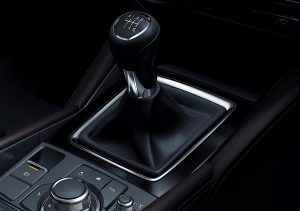
The difference is only about 4 MPG overall.
It doesn’t seem like much – and it’s not, as far as you and I are concerned; you know – the people who buy and drive the car. But as far as the government is concerned, it’s a huge difference.
Note that the CAFE fines mentioned above begin to apply when a car company’s “fleet average” dips below the sacred number, 35.5 MPG. Note further that the four cylinder versions of all these cars get there (or very close) as far as their highway numbers and their averages are not far behind.
The V6s, on the other hand . . . that slight dip really tamps down the average. Just like the single C you got in statistics did to your GPA back in school.
This is also probably why Mazda doesn’t offer a turbocharged version of the 2.5 liter engine, the one use in the larger/heavier CX-9.
But that engine’s 250 hp would definitely even things up.
This is a four door Miata – with twice the trunk space.
Like the Miata, it’s not all about the engine. It’s easy to make a car go fast. Just add more horsepower and stomp on the gas pedal. It’s trickier to make a car fun to drive.
The 6 excels at that, in spite of its relative horsepower deficit.
Part of the fun is working the revvy (7,000 RPM-capable) four cylinder engine via the manual transmission. Slipping the clutch, heel-and-toe-work. This is a pleasure not available in the automatic-only six cylinder competition.
Acceleration by itself is not always exciting. When you aren’t involved in the process, merely along for the ride. A coach seat in an Airbus – vs. being in the open cockpit of a Stearman barnstormer.
And there is lateral acceleration.
All modern cars “handle” well in the sense that they don’t pop hubcaps or squeal tires in the corners – unless you’re taking those corners at least 10 MPH over the posted limit (and usually more like 20).
All new cars feel more stable at 80 than the cars of 30 years ago felt at 60.
What separates the 6 from the family car herd is not just the ability to snake through the esses with guile, but the way it feels in your hands as it does so. Mazda controls body roll without resorting to ultra-stiff coil springs and struts – the general practice in sporty cars – which will shake loose any kidney stones you may have in the process. The 6 rides softly – almost as softly as a Camry – but unlike the Camry, this softeness in no way impinges on its ability to thread the needle. Mazda relies on thick anti-roll bars – and torque vectoring control to get that effect.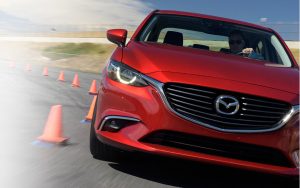
Torque vectoring is not traction control or even stability control – systems that use the ABS system to automatically apply the brakes to correct the vehicle’s line during cornering. These are reactive system. Torque vectoring is different. It works by using engine braking (modulated via subtle alterations of ignition timing and power delivery) to weight the front wheels during high-G cornering, effectively increasing their contact patch and thereby, their grip on the road.
The system is totally in the background – unlike traction and stability control, which you can feel come on when the brakes are pumped (and throttle suddenly cut). These after-the-fact systems may keep the car under control, but they do not enhance the feeling of being in control.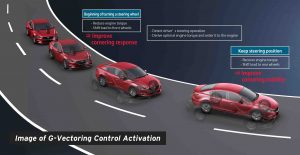
Which brings a couple of other/related things.
The 6 has traction/stability control (they all do) but unlike some, you can turn the 6’s systems off and while in motion and they do not come back on, insolently, once the car reaches a certain speed.
You decide; you are in control.
Also: The 6 does not have an electronic speed limiter. Regardless of trim – and whether you go with the six-speed manual or the optional six-speed automatic – top speed is 137 MPH. Some others make you pay extra for their top speed. Not directly. But by up-selling you to the optional engine, or making you buy an optional wheel/tire package.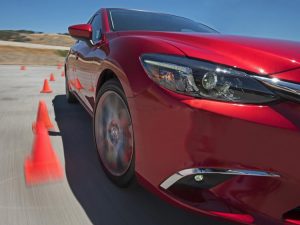
Otherwise, you get a lower top speed.
For maximum responsiveness, you’ll want the manual-equipped car with the available 4.10 final drive ratio; 3.81 is standard otherwise (with the automatic, too). If you want maximum mileage, Mazda offers an “e-loop” option that reduces the final drive to a more MPG-friendly 3.59 ratio – but be aware the car will feel less peppy coming off the line.
AT THE CURB
The 6 may not have a six, but it has looks in its corner.
Not that the Camry, Accord or Altima – and the others in this class – are ugly cars. But they are as forgettable as yesterday’s oatmeal. From the side, most of them look as though the panels interchange.
No panel on the 6 looks like it would fit a Camry or an Accord – or any other car in this segment. It is a visually arresting car without being Too Much. Elegant is the right word here. And given the starting price, that is exceptional. The 6 does not look like a lesser car when it is parked next to a $50,000 Mercedes CLS or BMW 640i.
It makes them look lesser – given what they cost.
That’s not car press hagiography. It’s an acknowledgement of this car’s price-transcendant beauty. And it is proof that form does not have to follow function.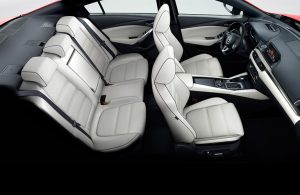
The 6 is as practical a car as the more appliance-like cars it competes with.
Front and rear seat legroom (42.2 inches and 38.7 inches, respectively) is as generous as in the Oatmeal Special Camry (41.6 inches front, 38.9 inches rear) and the Accord (42.5 inches front, 38.5 inches rear) and much less lopsided than the front-passenger-friendly but second-row-not-so-much Altima (45 inches up front but just 36.1 inches in back).
This practical interior space is also just as easy on the eyes as the car’s exterior. And – mostly – as easy to use.
Here we come to the one not-so-great thing about the 6 – about current Mazdas, generally: The control interface for the audio system, GPS and in-car apps.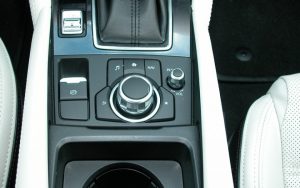
It can’t be faulted on looks. But function isn’t as good as the more practical systems in rival cars. It’s a two-step process to – as an example – change the radio station. First, you rotate the knob on the console to select << or >> (to go up or go down) then you push the knob to select.
You can end-run some of this by using secondary controls on the steering wheel – which you can also order heated.
Also the back seats. In both cases, these are things that – as recently as five years ago – were only available in much-pricier cars.
It’s just a shame that the wagon version isn’t available in the U.S.
Mazda is not the only manufacturer feeling the pressure to nix sixes. Next year (2018) the Accord will also lose its currently available V6. In its place, a turbocharged four. And that engine will be paired up with a ten-speed automatic transmission. Better hope it never breaks after the warranty expires.
All because of the CAFE fatwas – and not just the current (35.5 MPG) one. The 2018 Accord is the result of worry about the proposed uptick to 54.5 MPG by 2025, a fatwa that Trump promised he’d rescind but the threat still looms.
If it does go into effect, we’ll be lucky to get 2 liter fours – and forget manual transmissions, because they are impossible to program to do well on Uncle’s fuel economy test loops.
Meanwhile, the 6 – though it doesn’t offer a six – isn’t afflicted by these over-the-top technological Band-Aids. 
Not yet.
Carpe Diem.
While you still can.
THE BOTTOM LINE
Despite the 6 not offering one, it’s still the standout in this class of car – if you care about driving – and have a wandering eye.
If you like what you’ve found here, please consider supporting EPautos.
We depend on you to keep the wheels turning!
Our donate button is here.
If you prefer not to use PayPal, our mailing address is:
EPautos
721 Hummingbird Lane SE
Copper Hill, VA 24079
PS: EPautos stickers are free to those who send in $20 or more to support the site. Also, the eBook – free! – is available. Click here. Just enter you email in the box on the top of the main page and we’ll send you a copy ASAP.


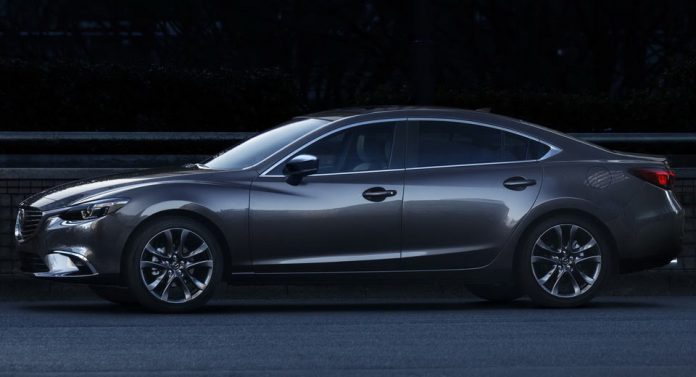

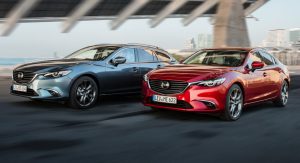
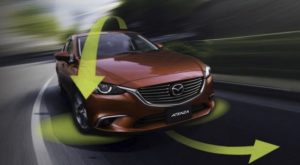


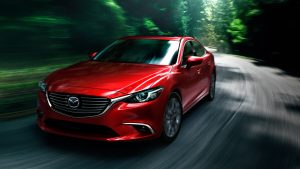









I like the 6 a lot and almost bought one last year. I wanted the Touring model with a manual and couldn’t get one. Like many other cars where the manufacturer offers a manual, the dealers do not.
been driving my freestyle fwd for 12 yrs now getting 22 mpg with 18 inch wheels, hauling the kids and cargo. v6 normal power have never had trouble getting the power band right, for passing power in the hills, mountains flatland. its a little loud passing, but cruising at 80 plus the noise is more contigent on how the car was built, so my point is the cvt’s are very underrated, noise vs performance is neglible.
as an aside, volks and the 2.5 vs mazada sky activ, everyone complained how gutless the 2.5 was, but volks and their tranny’s low end always made those cars extremely drivable for everyday driving. turbo’s are fun, but for everyday people the 2.5 and skyactiv are probably the best in between for the ave driver out there looking for performance and pocketbook.
I own a 2016 Mazda6 iSport. I bought it from CarMax with 37,000 miles (it started life as a rental car). My wife and I have run it to nearly 70,000 miles now (we make a lot of long trips to visit in-laws) with no mechanical issues whatsoever. I have an independent garage change the oil and filter with 0-w20 “Mazda w/ moly” oil and OEM filter I bought from Amazon in bulk every ~5k miles. I topped off the radiator reservoir with Mazda-spec “green” coolant once. Other than that, there has been no maintenance to do yet.
I do love the car. The seats are very comfortable, in particular, for long road trips. I have the cloth seats and I think that is better than leatherette for long trips, particularly in summer.
Once in awhile, when on a curvy backroad, I press the transmission lever left into manual mode and press the “sport” button. Then I enjoy revving the torque-y and willing SkyActiv motor to >6500 and getting every last drop of power from it while carving turns with the excellent, precise steering. There is some body roll, but it is predictable and the car doesn’t get unsettled easily.
Somewhere on the interwebs there is a good article detailing the engineering that went into the skyactiv-g motor. There are a number of features used in the engine due to the extreme compression ratio that have much in common with genuine racing engines, like the 4-2-1 exhaust manifold and the extremely close tolerances in the pistons. They also use forged crankshafts, unique piston shapes to prevent knocking, and multi-hole fuel injection. Mazda also reduced friction in the engine by up to 30%. A not small achievement. Basically the SkyActiv-G is an under-appreciated technical marvel.
The aftermarket tuners would support the notion that the SkyActiv-G 2.5L is capable of much more than 185 HP and 13:1 compression. People who reflash the ECU and use 91 octane report 20-30 HP gains and more torque as well. The European version of this car is tuned for 91 octane, 14:1 compression and makes more HP as a result.
Mazda calls the 6 their “sport sedan.” If they would just issue a special “Speed6” version with a tuned SkyActiv-G making 220-250 HP and all-wheel drive, this car would be just about perfect and a serious competitor for the 3-series. It’s ashame there are no plans to do so, or even to bring the turbo Skyactiv-G coming to the CX-5 into the Mazda6. Shouldn’t the “Sport Sedan” get the turbo motor before the “soccer mom”-mobile ??
I have the 2016 mazda6. Love it. Only downside is that windows fog up pretty bad sometimes and road noise was louder than expected.
Hi C_lover,
Mazda has become, for me, what BMW was 30 years ago. They build cars for people who appreciate fine machinery and who like to drive.
A couple of quick thoughts:
1. Running a 13.0:1 compression (some Skyactive G engines run 14.0:1) is achieved in part using direct injection, which cools the cylinder walls by directly injecting cool gasoline into the cylinder itself. In many direct-injection engines today this is causing problems with carbon buildup on the intake valves which takes 80k miles or more to start manifesting in lowered cylinder compression (due to poor sealing/seating of the valve b/c of carbon buildup) and worse efficiency and performance. This is one of those delayed problems that almost never would manifest during the warranty periods of most cars. Thus the manufacturer doesn’t have to repair what is essentially a design problem.
However, this sort of carbon buildup on the intake valve is only really a concern on turbocharged engines, and you’ll note that the Mazda 6’s is NOT a turbo engine. In the good old days, you could clean the intake valves by injecting a cleaning solution either a) into the fuel line as it entered the engine and, therefore, would be sprayed into the intake upstream of the intake valves and do the cleaning, or b) into the air intake path upstream of the intake valves as well. This is problematic for turbocharged engines as any carbon particles/flakes that come off the intake valve will pass through the exhaust system and likely enter the turbocharger impeller, nuking that turbo. Imagine dropping a rock into a jet engine. However, for non-turbo engines like the Mazda 6’s, there is no turbo to damage and the carbon particles will exit out the tailpipe no fuss, no muss.
Makes me wonder if that wasn’t part of Mazda’s plan and why they didn’t turbocharge.
2. I wonder if it would be possible to calculate the cost differential between the 4-cylinder and 6-cylinder models of passenger cars that were otherwise identically equipped over, say, the past 10-15 years or so. It may be difficult as in many cases the V6s are also the higher trim level cars or require the higher trim, so doing an otherwise equivalent trim/spec and tracking the isolated cost of the engine upgrade may be difficult for some models or some years.
I would speculate that the upcharge for the V6 over the I4 has been growing faster than the overall price of the car has for any given model. I would also speculate that this cost differential is accelerating as CAFE requirements come online.
My reasoning is simple economics. It’s a little prestigious for a car model to offer a V6 option even though the vast majority of that model will be sold with I4s. At least people would feel like they could, if they wanted to, but it just “wasn’t worth the price” to jump from a 4 to a 6. For the car company, the more expensive the upgrade, the fewer customers will take that upgrade and the better their CAFE numbers look. If 40 out of 100 people would opt for the V6 if it only cost $1,000 more, then it brings down their CAFE number. If, however, they increase that differential to $2,500, then perhaps only 15 or 10 out of 100 would upgrade. That directly and noticeably impacts the CAFE number as well as the potential customer’s pocketbook. In reality, it’s not much more expensive to mass manufacture a V6 than an I4 (though there is definitely a cost increase as you have to double camshafts, increase complexity, add injectors and plugs, etc.).
It’s well known in marketing that if you offer three options, an entry-level option, a mid-level option, and a “luxury” option on the high end, most folks will pick the middle option. They’ll feel they’re getting a bit more value by getting “some” of the luxury high-end options that they really wanted but keeping the cost closer to the entry-level appealing price point. It’s the compromise, and most folks are compromisers. For the company, they have higher profit margins on the luxury option, but if they can move enough mid-range models it works in their favor in the long run. The V6 is, sadly, becoming aspirational (and a V8 is downright obscene).
In 2018 if anyone is in the market for a reliable sedan, with a V6 engine, the Camry will certainly have an advantage with 301hp.
If, and when, Toyota makes available AWD, with the V6, I’ll definitely be in the market.
Hi Liberty,
I wonder how long Toyota will be able to hold out. As I mentioned in the article, Honda is dropping the V6 and going with a turbo four. All Because CAFE.
I think the Camry will be the last sedan in this class that still offers a V6.
It would be difficult to guess whether the Camry will have an advantage with the V6 or Toyota made a mistake. With most American car buyers content with “appliances” I wouldn’t want to have to determine what might be a successful vehicle for a manufacture to produce.
I’d really like the Camry V6 driveline in the RAV4 – but apparently that’s not going to happen. As close to what I’d prefer is a 2018 BMW X3 – but too expensive and not as reliable.
edit/correction: “You save about $3 per tank filling up the 6’s 16.4 gallon tank with regular vs. premium.”
Thanks, Ready – fixed!
“But the price you pay for that slight MPG advantage is the disadvantage of the CVT’s shrieky operating characteristics”
It’s understandable that the way you test drive vehicles — doing your due diligence by wringing out the engines to see how well the car performs — would bias you against CVTs, since that driving in a CVT will result in an engine howling away, especially in an underengined car.
But, what is the alternative? Which alternative is better for performance and mileage?
In a CVT, when you stomp on the gas, you get in the perfect “gear” right away. In a conventional automatic, there’s a lag — similar to the infamous turbo lag in older cars– before the transmission downshifts, and even then you’ll pretty much always be in a suboptimal gear ratio.
Basically, in a CVT, you’re always instantly in the ideal gear ratio, while in conventional automatics you’re … not. A ten speed automatic is an imperfect attempt to replicate the CVT’s performance, and it is crazy expensive and so complex it is easier to break.
It seems to me that CVTs are an elegant solution to an engineering problem, and the only reason to not put one in a car is when the engine puts out enough power that it would break the CVT.
As I see it, the “shriekiness” is a feature, not a bug — it’s the sound of a drivetrain responding to what your foot stomped to the floor is telling it to do — “get me maximum power right now”. If the noise bothers you, ease off the gas a bit.
Hi Jim,
I drive these cars, as you know – all of them. And CVTs are almost always thrashy/noisy and not in a pleasant way. The only reason we’re seeing them mass-produced is because of the slight MPG advantage they offer.
I rented an Altima with the V6. The engine has plenty of pep, but the CVT is noisy!
The range is really good though, it got over 600 miles on a single tank of gas.
Hi Rich,
Yup, that’s been my experience as well. Not just the Nissan but generally. CVTs are noisier than conventional automatics and not only when accelerating. They also lack the torque multiplication advantage of a conventional automatic. They’re not “bad” transmissions, but I haven’t yet experienced one that is superior, in terms of operating characteristics/performance, to a conventional automatic.
They are MPG enhancers.
Rich,my first round with a CVT was also an Altima. Acceleration was impressive but it took me back to an open tractor pulling a row binder and pulling the throttle knob out so the engine would turn faster than normal WOT.
It made me wonder how much of that the driveline would stand. Other cars left me with the same worry.
I may be wrong and probably am but that sort of elevated “trashy thrashy” noise always makes me think of short life.
When I hear that sort of thing it reminds me of 70s and 80’s Ford work trucks with Slushomatics in them.
A one ton truck heavily loaded and pulling a big trailer with something like a big Ditch Witch and when you held it to the floor it would get to a barrier of a sorts that was hard to break,just hanging there engine all revved up and not quite able to shift into 3rd but making a lot of transmission noise which in turn reminded me being too “altered”,for lack of a less crass phrase, while having sex and reaching a point where the brain or heart might fail before that final “gear change”. You could often tell the woman was probably wondering same so it was a double relief/release for her too…..and if you couldn’t make it and had to “pull off to the side and cool down” and said “I’ll be ok in a few”, they might say “don’t worry about it” which was code for “I’m just glad it wasn’t a call for an ambulance”.
Of course, I personally never had that happen, I only heard that story…..aha
Hell of a story just to describe a difficult gear change.
Hi Jim,
The fuel efficiency advantage is trivial, as far as the buyer is concerned. 2-3 MPG is typical vs. a conventional automatic. The operating characteristics of the conventional automatic are superior, meanwhile.